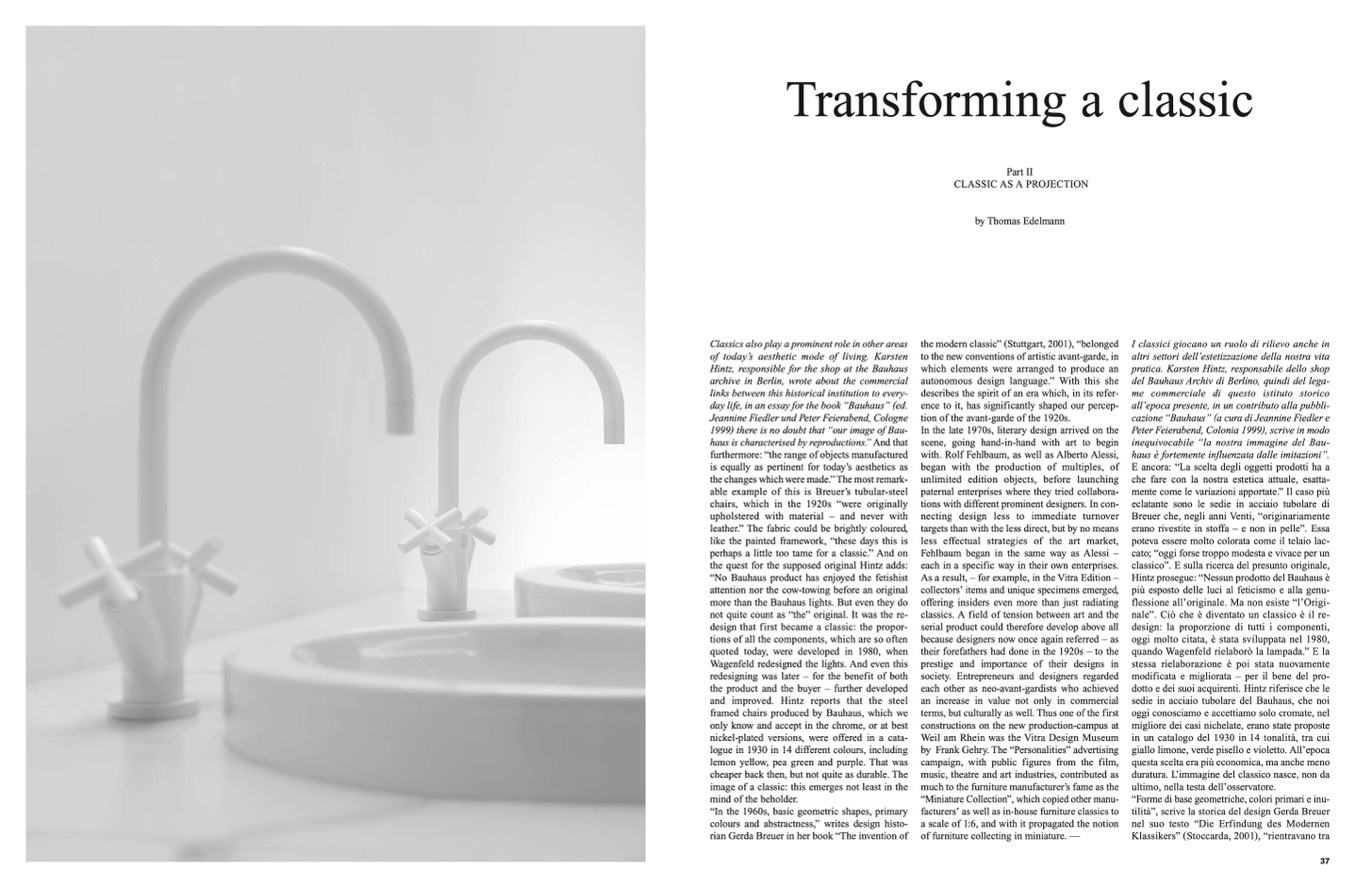
Transforming a classic
Classics also play a prominent role in other areas
of today’s aesthetic mode of living. Karsten
Hintz, responsible for the shop at the Bauhaus
archive in Berlin, wrote about the commercial
links between this historical institution to every-
day life, in an essay for the book “Bauhaus” (ed.
Jeannine Fiedler und Peter Feierabend, Cologne
1999) there is no doubt that “our image of Bau-
haus is characterised by reproductions.” And that
furthermore: “the range of objects manufactured
is equally as pertinent for today’s aesthetics as
the changes which were made.” The most remark-
able example of this is Breuer’s tubular-steel
chairs, which in the 1920s “were originally
upholstered with material – and never with
leather.” The fabric could be brightly coloured,
like the painted framework, “these days this is
perhaps a little too tame for a classic.” And on
the quest for the supposed original Hintz adds:
“No Bauhaus product has enjoyed the fetishist
attention nor the cow-towing before an original
more than the Bauhaus lights. But even they do
not quite count as “the” original. It was the re-
design that first became a classic: the propor-
tions of all the components, which are so often
quoted today, were developed in 1980, when
Wagenfeld redesigned the lights. And even this
redesigning was later – for the benefit of both
the product and the buyer – further developed
and improved. Hintz reports that the steel
framed chairs produced by Bauhaus, which we
only know and accept in the chrome, or at best
nickel-plated versions, were offered in a cata-
logue in 1930 in 14 different colours, including
lemon yellow, pea green and purple. That was
cheaper back then, but not quite as durable. The
image of a classic: this emerges not least in the
mind of the beholder.
“In the 1960s, basic geometric shapes, primary
colours and abstractness,” writes design histo-
rian Gerda Breuer in her book “The invention of
Part II
CLASSIC AS A PROJECTION
by Thomas Edelmann
the modern classic” (Stuttgart, 2001), “belonged
to the new conventions of artistic avant-garde, in
which elements were arranged to produce an
autonomous design language.” With this she
describes the spirit of an era which, in its refer-
ence to it, has significantly shaped our percep-
tion of the avant-garde of the 1920s.
In the late 1970s, literary design arrived on the
scene, going hand-in-hand with art to begin
with. Rolf Fehlbaum, as well as Alberto Alessi,
began with the production of multiples, of
unlimited edition objects, before launching
paternal enterprises where they tried collabora-
tions with different prominent designers. In con-
necting design less to immediate turnover
targets than with the less direct, but by no means
less effectual strategies of the art market,
Fehlbaum began in the same way as Alessi –
each in a specific way in their own enterprises.
As a result, – for example, in the Vitra Edition –
collectors’ items and unique specimens emerged,
offering insiders even more than just radiating
classics. A field of tension between art and the
serial product could therefore develop above all
because designers now once again referred – as
their forefathers had done in the 1920s – to the
prestige and importance of their designs in
society. Entrepreneurs and designers regarded
each other as neo-avant-gardists who achieved
an increase in value not only in commercial
terms, but culturally as well. Thus one of the first
constructions on the new production-campus at
Weil am Rhein was the Vitra Design Museum
by Frank Gehry. The “Personalities” advertising
campaign, with public f igures from the f ilm,
music, theatre and art industries, contributed as
much to the furniture manufacturer’s fame as the
“Miniature Collection”, which copied other manu-
facturers’ as well as in-house furniture classics to
a scale of 1:6, and with it propagated the notion
of furniture collecting in miniature. —
I classici giocano un ruolo di rilievo anche in
altri settori dell’estetizzazione della nostra vita
pratica. Karsten Hintz, responsabile dello shop
del Bauhaus Archiv di Berlino, quindi del lega-
me commerciale di questo istituto storico
all’epoca presente, in un contributo alla pubbli-
cazione “Bauhaus” (a cura di Jeannine Fiedler e
Peter Feierabend, Colonia 1999), scrive in modo
inequivocabile “la nostra immagine del Bau-
haus è fortemente influenzata dalle imitazioni”.
E ancora: “La scelta degli oggetti prodotti ha a
che fare con la nostra estetica attuale, esatta-
mente come le variazioni apportate.” Il caso più
eclatante sono le sedie in acciaio tubolare di
Breuer che, negli anni Venti, “originariamente
erano rivestite in stoffa – e non in pelle”. Essa
poteva essere molto colorata come il telaio lac-
cato; “oggi forse troppo modesta e vivace per un
classico”. E sulla ricerca del presunto originale,
Hintz prosegue: “Nessun prodotto del Bauhaus è
più esposto delle luci al feticismo e alla genu-
flessione all’originale. Ma non esiste “l’Origi-
nale”. Ciò che è diventato un classico è il re-
design: la proporzione di tutti i componenti,
oggi molto citata, è stata sviluppata nel 1980,
quando Wagenfeld rielaborò la lampada.” E la
stessa rielaborazione è poi stata nuovamente
modificata e migliorata – per il bene del pro-
dotto e dei suoi acquirenti. Hintz riferisce che le
sedie in acciaio tubolare del Bauhaus, che noi
oggi conosciamo e accettiamo solo cromate, nel
migliore dei casi nichelate, erano state proposte
in un catalogo del 1930 in 14 tonalità, tra cui
giallo limone, verde pisello e violetto. All’epoca
questa scelta era più economica, ma anche meno
duratura. L’immagine del classico nasce, non da
ultimo, nella testa dell’osservatore.
“Forme di base geometriche, colori primari e inu-
tilità”, scrive la storica del design Gerda Breuer
nel suo testo “Die Erfindung des Modernen
Klassikers” (Stoccarda, 2001), “rientravano tra
37

